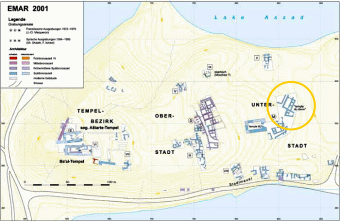The Lexical Texts from Emar

Map of the excavations at Emar, with house M1. © Emar Projekt [http://www.uni-tuebingen.de//uni/aaa/en/legals.html] University of Tübingen.
The city of Emar, at the great bend in the Euphrates, yielded numerous cuneiform tablets, including several hundred lexical texts of great variety. The Emar tablets are roughly contemporaneous with the texts from Ugarit and the lexical traditions from the two towns are very similar. At the time both Ugarit and Emar belonged to the Hittite empire, under the viceroy at Charchemish.
Nearly all Emar texts were found in house M1, which was the residence of the Zū-Baʾla family. The head of the household held the title Diviner of the Gods, a hereditary title that implied a number of ritual obligations and entitlements.
The Diviner of the Gods was an Emar citizen who was employed by the Hittite administration and played a role in the balance of power within the city. Emar was the capital of the kingdom Aštata; the kingdom and the city had kept their own political structures, largely independent from the Hittite overlords. The presence of officials in service of the Hittite king, such as Zū-Baʾla, provided an aspect of direct control by the city's overlords. As an employee of the Hittites Zū-Baʾla dealt not only with the viceroy in Charcemish; on occasion he was in direct contact with the Hittite king, and he enjoyed his protection.
The cuneiform corpus of Emar has been divided into two groups, traditionally labeled "Syrian" and "Syro-Hittite," primarily based on paleography, orthography and tablet format. Syrian texts tend to be slightly older than those of the Syro-Hittite group.
| Sa Vocabulary | Sa sign list with Akkadian translations |
| Saŋ | Rare bilingual acrographic list |
| Ura | Thematic lists (unilingual Sumerian) |
The Syrian lexical texts from Emar were kept in the Zū-Baʾla residence as scribal heirlooms. They include several chapters of the ubiquitous thematic list Ura (in Sumerian only), but also a rare copy (almost complete) of the acrographic list Saŋ (bilingual). The colophons of the Syrian lexical texts contain names that are barely known from other Emar texts. The scribe of the Saŋ tablet, named Baʾal-bārû, has been linked to a family that held the title Diviner of the Gods before Zū-baʾla rose to that position.
| Sa Vocabulary | Sa sign list with Akkadian translations |
| Diri | List of compound signs |
| Lu₂ | Professions |
| Izi | Acrographic list |
| Nigga | Acrographic list |
| Syllable Vocabulary A | Syllable Alphabet A with speculative Akkadian translations |
| Ura | Thematic lists (mostly bilingual) |
The Syro-Hittite lexical texts from Emar are much more numerous and relate directly to the educational activities at the Zū-baʾla residence. This group includes several exercise texts (extracts) and a number of large tablets that are signed (in the colophon) by members of the Zū-baʾla family. The great majority of tablets contain chapters of the thematic list Ura in a bilingual format, but there are also examples of other lexical series.
27 Dec 2019
Further reading
- Arnaud, Daniel 1987 Textes de la bibliothèque: transcriptions et traductions. Recherches au Pays d'Aštata. Emar 6/4. Paris: Editions Recherche sur les Civilisations.
- Civil, Miguel 1989 The Texts from Meskene-Emar. Aula Orientalis 7: 5-25. Download.
- Cohen, Yoram 2009 The Scribes and Scholars of the City of Emar in the Late Bronze Age. Harvard Semitic Studies 59. Winona Lake, Indiana: Eisenbrauns.
- Gantzert, Merijn 2008 The Emar Lexical Texts. Part 1-4. Maastricht: Uitgeverij Boekenplan. Download.
- Yamada, Masamichi 2006 The Hittite Administration in Emar: The Aspect of Direct Control. Zeitschrift für Assyriologie 96: 222-34. Download (subscription needed).
Niek Veldhuis
Niek Veldhuis, 'The Lexical Texts from Emar', Digital Corpus of Cuneiform Lexical Texts, The DCCLT Project, 2019 [http://oracc.museum.upenn.edu/dcclt/lexicallistsperiods/middlebabylonian/emar/]